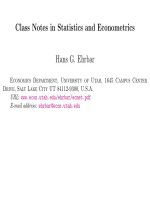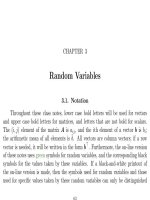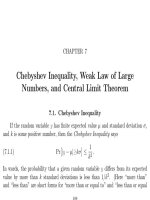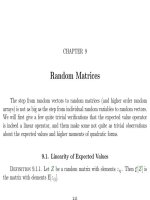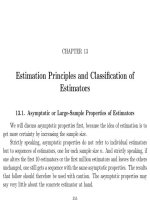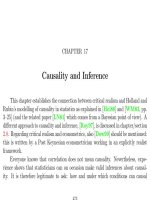Class Notes in Statistics and Econometrics Part 3 pdf
Bạn đang xem bản rút gọn của tài liệu. Xem và tải ngay bản đầy đủ của tài liệu tại đây (418.65 KB, 49 trang )
CHAPTER 5
Specific Random Variables
5.1. Binomial
We will b e gin with mean and variance of the binomial variable, i.e., the number
of successes in n independent repetitions of a Be rnoulli trial (3.7.1). The binomial
variable has the two parameters n and p. Let us look first at the case n = 1, in which
the binomial variable is also called indicator variable: If the event A has probability
p, then its complement A
has the probability q = 1 − p. The indicator variable of
A, which assumes the value 1 if A occurs, and 0 if it doesn’t, has expected value p
and variance pq. For the binomial variable with n observations, which is the sum of
n independent indicator variables, the expected value (mean) is np and the variance
is npq.
139
140 5. SPECIFIC RANDOM VARIABLES
Problem 79. The random variable x assumes the value a with probability p and
the value b with probability q = 1 −p. Show that var[x] = pq(a −b)
2
.
Answer. E[x] = pa + qb; var[x] = E[x
2
] − (E[x])
2
= pa
2
+ qb
2
− (pa + qb)
2
= (p − p
2
)a
2
−
2pqab + (q − q
2
)b
2
= pq(a − b)
2
. For this last equality we need p −p
2
= p(1 −p) = pq.
The Negative Binomial Variable is, like the binomial variable, derived from the
Bernoulli experiment; but one reverses the question. Instead of asking how many
successes one gets in a given number of trials, one asks, how m any trials one must
make to get a given number of successes, say, r successes.
First look at r = 1. Let t denote the number of the trial at which the first success
occurs. Then
(5.1.1) Pr[t=n] = pq
n−1
(n = 1, 2, . . .).
This is called the geometric probability.
Is the probability derived in this way σ-additive? The sum of a geometrically
declining sequence is easily computed:
1 + q + q
2
+ q
3
+ ··· = s Now multiply by q:(5.1.2)
q + q
2
+ q
3
+ ··· = qs Now subtract and write 1 −q = p:(5.1.3)
1 = ps(5.1.4)
5.1. BINOMIAL 141
Equation (5.1.4) means 1 = p + pq + pq
2
+ ···, i.e., the sum of all probabilities is
indeed 1.
Now what is the expected value of a geometric variable? Use definition of ex-
pected value of a discrete variable: E[t] = p
∞
k=1
kq
k−1
. To evaluate the infinite
sum, solve (5.1.4) for s:
s =
1
p
or 1 + q + q
2
+ q
3
+ q
4
··· =
∞
k=0
q
k
=
1
1 − q
(5.1.5)
and differentiate both sides with respect to q:
1 + 2q + 3q
2
+ 4q
3
+ ··· =
∞
k=1
kq
k−1
=
1
(1 − q)
2
=
1
p
2
.(5.1.6)
The expected value of the geometric variable is therefore E[t] =
p
p
2
=
1
p
.
Problem 80. Assume t is a geometric random variable with parameter p, i.e.,
it has the values k = 1, 2, . . . with probabilities
(5.1.7) p
t
(k) = pq
k−1
, where q = 1 −p.
The geometric variable denotes the number of times one has to perform a Bernoulli
experiment with success probability p to get the first success.
142 5. SPECIFIC RANDOM VARIABLES
• a. 1 point Given a positive integer n. What is Pr[t>n]? (Easy with a simple
trick!)
Answer. t>n means, the first n trials must result in failures, i.e., Pr[t>n] = q
n
. Since
{t > n} = {t = n + 1} ∪{t = n + 2} ∪···, on e can also get the same result in a more tedious way:
It is pq
n
+ pq
n+1
+ pq
n+2
+ ··· = s, say. Therefore qs = pq
n+1
+ pq
n+2
+ ···, and (1 −q)s = pq
n
;
since p = 1 − q, it follows s = q
n
.
• b. 2 points Let m and n be two positive integers with m < n. Show that
Pr[t=n|t>m] = Pr[t=n − m].
Answer. Pr[t=n|t>m] =
Pr[t=n]
Pr[t>m]
=
pq
n−1
q
m
= pq
n−m−1
= Pr[t=n − m].
• c. 1 point Why is this property called the memory-less property of the geometric
random variable?
Answer. If you have already waited for m periods wi thou t succe ss, the probability that success
will come in the nth period is the same as the probability that it comes in n − m periods if you
start now. Obvious if you remember that geometric random variable is time you have to wait until
1st success in Bernoulli trial.
Problem 81. t is a geometric random variable as in the preceding problem. In
order to compute var[t] it is most convenient to make a detour via E[t(t − 1)]. Here
are t he steps:
5.1. BINOMIAL 143
• a. Express E[t(t − 1)] as an infinite sum.
Answer. Just write it down according to the definition of expected values:
∞
k=0
k(k −
1)pq
k−1
=
∞
k=2
k(k −1)pq
k−1
.
• b. Derive the formula
(5.1.8)
∞
k=2
k(k −1)q
k−2
=
2
(1 − q)
3
by the same trick by which we derived a similar formula in class. Note that the sum
starts at k = 2.
Answer. This is just a second time differentiating the geometric series, i.e., first time differ-
entiating (5.1.6).
• c. Use a. and b. to derive
(5.1.9) E[t(t − 1)] =
2q
p
2
Answer.
(5.1.10)
∞
k=2
k(k −1)pq
k−1
= pq
∞
k=2
k(k −1)q
k−2
= pq
2
(1 − q)
3
=
2q
p
2
.
144 5. SPECIFIC RANDOM VARIABLES
• d. Use c. and the fact that E[t] = 1/p to derive
(5.1.11) var[t] =
q
p
2
.
Answer.
(5.1.12) var[t] = E[t
2
] − (E[t])
2
= E[t(t − 1)] + E[t] − (E[t])
2
=
2q
p
2
+
1
p
−
1
p
2
=
q
p
2
.
Now let us look at the negative binomial with arbitrary r. What is the probability
that it takes n trials to get r successes? (That means, with n−1 trials we did not yet
have r successes.) The probability that the nth trial is a success is p. The probability
that there are r − 1 successes in the first n − 1 trials is
n−1
r−1
p
r−1
q
n−r
. Multiply
those to get:
(5.1.13) Pr[t=n] =
n − 1
r −1
p
r
q
n−r
.
This is the negative binomial, also called the Pascal probability distribution with
parameters r and p.
5.1. BINOMIAL 145
One easily gets the mean and variance, because due to the memory-less property
it is the sum of r independent geometric variables:
(5.1.14) E[t] =
r
p
var[t] =
rq
p
2
Some authors define the negative binomial as the number of failures before the
rth success. Their formulas will look slightly different than ours.
Problem 82. 3 points A fair coin is flipped until heads appear 10 times, and x
is the number of times tails appear before the 10th appearance of heads. Show that
the expected value E[x] = 10.
Answer. Let t be the number of the throw which gives the 10th head. t is a negative binomial
with r = 10 and p = 1/2, therefore E[t] = 20. Since x = t − 10, it follows E[x] = 10.
Problem 83. (Banach’s match-box problem) (Not eligible for in-class exams)
There are two restaurants in town serving hamburgers. In the morning each of them
obtains a shipment of n raw hamburgers. Every time someone in that town wants
to eat a hamburger, he or she selects one of the two restaurants at random. What is
the probability that the (n + k)th customer will have to be turned away because the
restaurant selected has run out of hamburgers?
Answer. For each restaurant it is the negative binomial probability distribution in disguise:
if a restaurant runs out of hamburgers this is like having n successes in n + k tries.
146 5. SPECIFIC RANDOM VARIABLES
But one can also reason it out: Assume one of the restaurantes must turn customers away
after the n + kth customer. Write down all the n + k decisions made: write a 1 if the customer
goes to the first restaurant, and a 2 if he goes to the second. I.e., write down n + k ones and twos.
Under what conditio ns will such a sequence result in the n +kth move eating the last hamburgerthe
first restaurant? Exact ly if it has n ones and k twos, a n + kth move is a one. As in the reasoning
for the negative binomial probability distribution, there are
n+k−1
n−1
possibilitie s, each of which
has probability 2
−n−k
. Emptying the second restaurant has the same probability. Together the
probability is therefore
n+k−1
n−1
2
1−n−k
.
5.2. The Hypergeometric Probability Distribution
Until now we had independent events, such as, repeated throwing of coins or
dice, sampling with replacement from finite populations, ar sampling from infinite
populations. If we sample without replacem ent from a finite population, the prob-
ability of the second element of the sample depends on what the first element was.
Here the hypergeometric probability distribution applies.
Assume we have an urn with w white and n −w black balls in it, and we take a
sample of m balls. What is the probability that y of them are white?
We are not interested in the order in which these balls are taken out; we may
therefore assume that they are taken out simultaneously, therefore the set U of
outcomes is the set of subsets containing m of the n balls. The total number of such
subsets is
n
m
. How many of them have y white balls in them? Imagine you first
5.2. THE HYPERGEOMETRIC PROBABILITY DISTRIBUTION 147
pick y white balls from the set of all white balls (there are
w
y
possibilities to do
that), and then you pick m − y black balls from the set of all black balls, which can
be done in
n−w
m−y
different ways. Every union of such a set of white balls with a set
of black balls gives a set of m elements with exactly y white balls, as desired. There
are therefore
w
y
n−w
m−y
different such sets, and the probability of picking such a set
is
(5.2.1) Pr[Sample of m elements has exactly y white balls] =
w
y
n−w
m−y
n
m
.
Problem 84. You have an urn with w white and n−w black balls in it, and you
take a sample of m balls with replacement, i.e., after pulling each ball out you put it
back in before you pull out the next ball. What is the probability that y of these balls
are white? I.e., we are asking here for the counterpart of formula (5.2.1) if sampling
is done with replacement.
Answer.
(5.2.2)
w
n
y
n − w
n
m−y
m
y
148 5. SPECIFIC RANDOM VARIABLES
Without proof we will state here that the expected value of y, the number of
white balls in the sample, is E[y] = m
w
n
, which is the same as if one would select the
balls with replacement.
Also without proof, the variance of y is
(5.2.3) var[y] = m
w
n
(n − w)
n
(n − m)
(n − 1)
.
This is smaller than the variance if one would choose with replacement, which is
represented by the above formula without the last term
n−m
n−1
. This last term is
called the finite population correction. More about all this is in [Lar82, p. 176–183].
5.3. The Poisson Distribution
The Poisson distribution counts the number of events in a given time interval.
This number has the Poisson distribution if each event is the cumulative result of a
large number of independent possibilities, e ach of which has only a small chance of
occurring (law of rare events). The expected number of occurrences is proportional
to time with a proportionality factor λ, and in a short time span only zero or one
event can occur, i.e., for infinitesimal time intervals it becomes a Bernoulli trial.
Approximate it by dividing the time from 0 to t into n intervals of length
t
n
; then
the occurrences are approximately n independent Bernoulli trials with probability of
5.3. THE POISSON DISTRIBUTION 149
success
λt
n
. (This is an approximation since some of these intervals may have more
than one occurrence; but if the intervals become very short the probability of having
two occurrences in the same interval b e come s negligible.)
In this discrete approximation, the probability to have k successes in time t is
Pr[x=k] =
n
k
λt
n
k
1 −
λt
n
(n−k)
(5.3.1)
=
1
k!
n(n − 1) ···(n − k + 1)
n
k
(λt)
k
1 −
λt
n
n
1 −
λt
n
−k
(5.3.2)
→
(λt)
k
k!
e
−λt
for n → ∞ while k remains constant(5.3.3)
(5.3.3) is the limit because the se cond and the last term in (5.3.2) → 1. The sum
of all probabilities is 1 since
∞
k=0
(λt)
k
k!
= e
λt
. The expected value is (note that we
can have the sum start at k = 1):
(5.3.4) E[x] = e
−λt
∞
k=1
k
(λt)
k
k!
= λte
−λt
∞
k=1
(λt)
k−1
(k − 1)!
= λt.
This is the same as the expected value of the discrete approximations.
150 5. SPECIFIC RANDOM VARIABLES
Problem 85. x follows a Poisson distribution, i.e.,
(5.3.5) Pr[x=k] =
(λt)
k
k!
e
−λt
for k = 0, 1, . .
• a. 2 points Show that E[x] = λt.
Answer. See (5.3.4).
• b. 4 points Compute E[x(x − 1)] and show that var[x] = λt.
Answer. For E[x(x − 1)] we can have the sum start at k = 2:
(5.3.6) E[x(x − 1)] = e
−λt
∞
k=2
k(k −1)
(λt)
k
k!
= (λt)
2
e
−λt
∞
k=2
(λt)
k−2
(k − 2)!
= (λt)
2
.
From this follows
(5.3.7) var[x] = E[x
2
] − (E[x])
2
= E[x(x − 1)] + E[x] − (E[x])
2
= (λt)
2
+ λt −(λt)
2
= λt.
The Poisson distribution can be used as an approximation to the Binomial dis-
tribution when n large, p sm all, and np moderate.
Problem 86. Which value of λ would one need to approximate a given Binomial
with n and p?
5.3. THE POISSON DISTRIBUTION 151
Answer. That which gives the right expected value, i.e., λ = np.
Problem 87. Two researchers counted cars coming down a road, which obey a
Poisson distribution with unknown parameter λ. In other words, in an interval of
length t one will have k cars with probability
(5.3.8)
(λt)
k
k!
e
−λt
.
Their assignment was to count how many cars came in the first half hour, and how
many cars came in the second half hour. However they forgot to keep track of the
time when t he first half hour was over, and therefore wound up only with one count,
namely, they knew that 213 cars had come down the road during this hour. They
were afraid they would get fired if they came back with one number only, so they
applied the following remedy: they threw a coin 213 times and counted the number of
heads. This number, they pretended, was the number of cars in the first half hour.
• a. 6 points Did the probability distribution of the number gained in this way
differ from the distribution of actually counting the number of cars in the first half
hour?
Answer. First a few definitions: x is the total number of occurrences in the interval [0, 1]. y
is the number of occurrences in the interval [0, t] (for a fixed t; in the problem it was t =
1
2
, but we
152 5. SPECIFIC RANDOM VARIABLES
will do it for general t, which will make the notation clearer and more compact. Then we want to
compute Pr[y=m|x=n]. By definition of conditional probability:
(5.3.9) Pr[y=m|x=n] =
Pr[y=m and x=n]
Pr[x=n]
.
How can we compute the probability of the intersection Pr[y=m and x=n]? Use a trick: express
this intersection as the intersection of independent events. For this define z as the number of
events in the interval (t, 1]. Then {y=m and x=n} = {y=m and z=n − m}; therefore Pr[y=m and
x=n] = Pr[y=m] Pr[z=n − m]; use this to get
(5.3.10)
Pr[y=m|x=n] =
Pr[y=m] Pr[z=n − m]
Pr[x=n]
=
λ
m
t
m
m!
e
−λt
λ
n−m
(1−t)
n−m
(n−m)!
e
−λ(1−t)
λ
n
n!
e
−λ
=
n
m
t
m
(1−t)
n−m
,
Here we use the fact that Pr[x=k] =
t
k
k!
e
−t
, Pr[y=k] =
(λt)
k
k!
e
−λt
, Pr[z=k] =
(1−λ)
k
t
k
k!
e
−(1−λ)t
.
One sees that a. Pr[y=m|x=n] does not depend on λ, and b. it is exactly the probability of having m
successes and n −m failures in a Bernoulli trial with success probability t. Therefore the procedure
with the coins gave the two researchers a result which had the same probability distribution as if
they had counted the number of cars in each half hour separately.
• b. 2 points Explain what it means that the probability distribution of the number
for the first half hour gained by throwing the coins does not differ from the one gained
5.3. THE POISSON DISTRIBUTION 153
by actually counting the cars. Which condition is absolutely necessary for this to
hold?
Answer. The supervisor would never be able to find out through statistical analysis of the
data t hey delivered, even if they did it repeatedly. All estimation results based on the faked statistic
would be as accurate regarding λ as the true statistics. All this is only true under the assumption
that the cars really obey a Poisson distribution and that the coin is fair.
The fact that the Poisson as well as the binomial distributions are me moryle ss has nothing to
do with them having a sufficient statistic.
Problem 88. 8 points x is the number of customers arriving at a service counter
in one hour. x follows a Poisson distribution with parameter λ = 2, i.e.,
(5.3.11) Pr[x=j] =
2
j
j!
e
−2
.
• a. Compute the probability that only one customer shows up at the service
counter during the hour, the probability that two show up, and the probability that no
one shows up.
• b. Despite the small number of customers, two employees are assigned to the
service counter. They are hiding in the back, and whenever a customer steps up to
the counter and rings the bell, they toss a coin. If the coin shows head, Herbert serves
154 5. SPECIFIC RANDOM VARIABLES
the customer, and if it shows tails, Karl does. Compute the probability that Herbert
has to serve exactly one customer during the hour. Hint:
(5.3.12) e = 1 + 1 +
1
2!
+
1
3!
+
1
4!
+ ··· .
• c. For any integer k ≥ 0, compute the probability that Herbert has to serve
exactly k customers during the hour.
Problem 89. 3 points Compute the moment generating function of a Poisson
variable observed over a unit time interval, i.e., x satisfies Pr[x=k] =
λ
k
k!
e
−λ
and
you want E[e
tx
] for all t.
Answer. E[e
tx
] =
∞
k=0
e
tk
λ
k
k!
e
−λ
=
∞
k=0
(λe
t
)
k
k!
e
−λ
= e
λe
t
e
−λ
= e
λ(e
t
−1)
.
5.4. The Exponential Distribution
Now we will discuss random variables which are related to the Poisson distri-
bution. At time t = 0 you start observing a Poisson process, and the random
variable
t denotes the time you have to wait until the first occurrence. t can have
any nonnegative real number as value. One can derive its cumulative distribution
as follows. t>t if and only if there are no occurrences in the interval [0, t]. There-
fore Pr[t>t] =
(λt)
0
0!
e
−λt
= e
−λt
, and hence the cumulative distribution function
5.4. THE EXPONENTIAL DISTRIBUTION 155
F
t
(t) = Pr[t≤t] = 1 −e
−λt
when t ≥ 0, and F
t
(t) = 0 for t < 0. The density function
is therefore f
t
(t) = λe
−λt
for t ≥ 0, and 0 otherwise. This is called the exponential
density function (its discrete analog is the geometric random variable). It can also
be called a Gamma variable with parameters r = 1 and λ.
Problem 90. 2 points An exponential random variable t with parameter λ > 0
has the density f
t
(t) = λe
−λt
for t ≥ 0, and 0 for t < 0. Use this density to compute
the expected value of t.
Answer. E[t] =
∞
0
λte
−λt
dt =
∞
0
uv
dt = uv
∞
0
−
∞
0
u
vdt, where
u=t v
=λe
−λt
u
=1 v=−e
−λt
. One
can also use the more abbreviated notation =
∞
0
u dv = uv
∞
0
−
∞
0
v du, where
u=t dv
=λe
−λt
dt
du
=dt v=−e
−λt
.
Either way one obtains E[t] = −te
−λt
∞
0
+
∞
0
e
−λt
dt = 0 −
1
λ
e
−λt
|
∞
0
=
1
λ
.
Problem 91. 4 points An exponential random variable t with parameter λ > 0
has the density f
t
(t) = λe
−λt
for t ≥ 0, and 0 for t < 0. Use this density to compute
the expected value of t
2
.
Answer. One can use that Γ(r) =
∞
0
λ
r
t
r−1
e
−λt
dt for r = 3 to get: E[t
2
] = (1/λ
2
)Γ(3) =
2/λ
2
. Or all from scratch: E[t
2
] =
∞
0
λt
2
e
−λt
dt =
∞
0
uv
dt = uv
∞
0
−
∞
0
u
vdt, where
u = t
2
v
= λe
−λt
u
= 2t v = −e
−λt
. Therefore E[t
2
] = −t
2
e
−λt
∞
0
+
∞
0
2te
−λt
dt. The first term vanishes, for
156 5. SPECIFIC RANDOM VARIABLES
the second do it again:
∞
0
2te
−λt
dt =
∞
0
uv
dt = uv
∞
0
−
∞
0
u
vdt, where
u = t v
= e
−λt
u
= 1 v = −(1/λ)e
−λt
.
Therefore the second term becomes 2(t/λ)e
−λt
∞
0
+ 2
∞
0
(1/λ)e
−λt
dt = 2/λ
2
.
Problem 92. 2 points Does the exponential random variable with parameter
λ > 0, whose cumulative distribution function is F
t
(t) = 1 − e
−λt
for t ≥ 0, and
0 otherwise, have a memory-less property? Compare Problem 80. Formulate this
memory-less property and then verify whether it holds or not.
Answer. Here is the formulation: for s<t follows Pr[t>t|t>s] = Pr[t>t −s]. This does indeed
hold. Proof: lhs =
Pr[t>t and t>s]
Pr[t>s]
=
Pr[t>t]
Pr[t>s]
=
e
−λt
e
−λs
= e
−λ(t−s)
.
Problem 93. The random variable t denotes the duration of an unemployment
spell. It has the exponential distribution, which can be defi ned by: Pr[t>t] = e
−λt
for
t ≥ 0 (t cannot assume negative values).
• a. 1 point Use this formula to compute the cumulative distribution function
F
t
(t) and the density function f
t
(t)
Answer. F
t
(t) = Pr[t≤t] = 1 − Pr[t>t] = 1 − e
−λt
for t ≥ 0, zero otherwise. Taking the
derivative gives f
t
(t) = λe
−λt
for t ≥ 0, zero otherwise.
• b. 2 points What is the probability that an unemployment spell ends after time
t + h, given that it has not yet ended at time t? Show that this is the same as the
5.4. THE EXPONENTIAL DISTRIBUTION 157
unconditional probability that an unemployment spell ends after time h (memory-less
property).
Answer.
Pr[t>t + h|t>t] =
Pr[t>t + h]
Pr[t>t]
=
e
−λ(t+h)
e
−λt
= e
−λh
(5.4.1)
• c. 3 points Let h be a small number. What is the probability that an unemploy-
ment spell ends at or before t + h, given that it has not yet ended at time t? Hint:
for small h, one can write approximately
(5.4.2) Pr[t < t≤t + h] = hf
t
(t).
Answer.
Pr[t≤t + h|t>t] =
Pr[t≤t + h and t>t]
Pr[t>t]
=
=
h f
t
(t)
1 − F
t
(t)
=
h λe
−λt
e
−λt
= h λ.(5.4.3)
158 5. SPECIFIC RANDOM VARIABLES
5.5. The Gamma Distribution
The time until the second occurrence of a Poisson event is a random variable
which we will call t
(2)
. Its cumulative distribution function is F
t
(2)
(t) = Pr[t
(2)
≤t] =
1−Pr[t
(2)
>t]. But t
(2)
>t means: there are either zero or one occurrences in the time
between 0 and t; therefore Pr[t
(2)
>t] = Pr[x=0]+Pr[x=1] = e
−λt
+λte
−λt
. Putting it
all together gives F
t
(2)
(t) = 1−e
−λt
−λte
−λt
. In order to differentiate the cumulative
distribution function we need the product rule of differentiation: (uv)
= u
v + uv
.
This gives
(5.5.1) f
t
(2)
(t) = λe
−λt
− λe
−λt
+ λ
2
te
−λt
= λ
2
te
−λt
.
Problem 94. 3 points Compute the density function of t
(3)
, the time of the third
occurrence of a Poisson variable.
Answer.
Pr[t
(3)
>t] = Pr[x=0] + Pr[x=1] + Pr[x=2](5.5.2)
F
t
(3)
(t) = Pr[t
(3)
≤t] = 1 − (1 + λt +
λ
2
2
t
2
)e
−λt
(5.5.3)
f
t
(3)
(t) =
∂
∂t
F
t
(3)
(t) = −
−λ(1 + λt +
λ
2
2
t
2
) + (λ + λ
2
t)
e
−λt
=
λ
3
2
t
2
e
−λt
.(5.5.4)
5.5. THE GAMMA DISTRIBUTION 159
If one asks for the rth occurrence, again all but the last term cancel in the
differentiation, and one gets
(5.5.5) f
t
(r)
(t) =
λ
r
(r −1)!
t
r−1
e
−λt
.
This density is called the Gamma density with parameters λ and r.
The following definite integral, which is defined for all r > 0 and all λ > 0 is
called the Gamma function:
(5.5.6) Γ(r) =
∞
0
λ
r
t
r−1
e
−λt
dt.
Although this integral cannot be expressed in a closed form, it is an important
function in mathematics. It is a well behaved function interpolating the factorials in
the sense that Γ(r) = (r −1)!.
Problem 95. Show that Γ(r) as defined in (5.5.6) is independent of λ, i.e.,
instead of (5.5.6) one can also use the simpler equation
(5.5.7) Γ(r) =
∞
0
t
r−1
e
−t
dt.
160 5. SPECIFIC RANDOM VARIABLES
Problem 96. 3 points Show by partial integration that the Gamma function
satisfies Γ(r + 1) = rΓ(r).
Answer. Start with
(5.5.8) Γ(r + 1) =
∞
0
λ
r+1
t
r
e
−λt
dt
and integrate by parts:
u
vdt = uv −
uv
dt with u
= λe
−λt
and v = λ
r
t
r
, therefore u = −e
−λt
and v
= rλ
r
t
r−1
:
(5.5.9) Γ(r + 1) = −λ
r
t
r
e
−λt
∞
0
+
∞
0
rλ
r
t
r−1
e
−λt
dt = 0 + rΓ(r).
Problem 97. Show that Γ(r) = (r − 1)! for all natural numbers r = 1, 2, . .
Answer. Proof by induction. First verify that it holds for r = 1, i.e., that Γ(1) = 1:
(5.5.10) Γ(1) =
∞
0
λe
−λt
dt = −e
−λt
∞
0
= 1
and then, assuming that Γ(r) = (r −1)! Problem 96 says that Γ(r + 1) = rΓ(r) = r(r −1)! = r!.
Without proof: Γ(
1
2
) =
√
π. This will be shown in Problem 161.
5.5. THE GAMMA DISTRIBUTION 161
Therefore the following defines a density function, called the Gamma density
with parameter r and λ, for all r > 0 and λ > 0:
(5.5.11) f(x) =
λ
r
Γ(r)
x
r−1
e
−λx
for x ≥ 0, 0 otherwise.
The only application we have for it right now is: this is the distribution of the time
one has to wait until the rth occurrence of a Poisson distribution with intensity λ.
Later we will have other applications in which r is not an integer.
Problem 98. 4 points Compute the moment generating function of the Gamma
distribution.
Answer.
m
x
(t) = E[e
tx
] =
∞
0
e
tx
λ
r
Γ(r)
x
r−1
e
−λx
dx(5.5.12)
=
λ
r
(λ − t)
r
∞
0
(λ − t)
r
x
r−1
Γ(r)
e
−(λ−t)x
dx(5.5.13)
=
λ
λ − t
r
(5.5.14)
since the integrand in (5.5.12) is the density function of a Gamma distribution with parameters r
and λ − t.
162 5. SPECIFIC RANDOM VARIABLES
Problem 99. 2 points The density and moment generating functions of a Gamma
variable x with parameters r > 0 and λ > 0 are
(5.5.15) f
x
(x) =
λ
r
Γ(r)
x
r−1
e
−λx
for x ≥ 0, 0 otherwise.
(5.5.16) m
x
(t) =
λ
λ − t
r
.
Show t he following: If x has a Gamma distribution with parameters r and 1, then v =
x/λ has a Gamma distribution with parameters r and λ. You can prove this either
using the transformation theorem for densities, or the moment-generating function.
Answer. Solution using density function: The random variable whose density we know is x;
its density is
1
Γ(r)
x
r−1
e
−x
. If x = λv, then
dx
dv
= λ, and the absolute value is also λ. Therefore the
density of v is
λ
r
Γ(r)
v
r−1
e
−λv
. Solution using the mgf:
(5.5.17) m
x
(t) = E[e
tx
] =
1
1 − t
r
(5.5.18) m
v
(t) E[e
tv
] = E[e
(t/λ)x
] =
1
1 − (t/λ)
r
=
λ
λ − t
r
but this last expression can be recognized to be the mgf of a Gamma with r and λ.
5.5. THE GAMMA DISTRIBUTION 163
Problem 100. 2 points It x has a Gamma distribution with parameters r and
λ, and y one with parameters p and λ, and both are independent, show that x + y
has a Gamma distribution with parameters r + p and λ (reproductive property of the
Gamma distribution.) You may use equation (5.5.14) without proof
Answer.
(5.5.19)
λ
λ − t
r
λ
λ − t
p
=
λ
λ − t
r+p
.
Problem 101. Show that a Gamma variable x with parameters r and λ has
expected value E[x] = r/λ and variance var[x] = r/λ
2
.
Answer. Proof with moment genera ting function:
(5.5.20)
d
dt
λ
λ − t
r
=
r
λ
λ
λ − t
r+1
,
therefore E[x] =
r
λ
, and by differentiating twice (apply the same formula again), E[x
2
] =
r(r+1)
λ
2
,
therefore var[x] =
r
λ
2
.
Proof using density function: For the expected value one gets E[t] =
∞
0
t ·
λ
r
Γ(r)
t
r−1
e
−λt
dt =
r
λ
1
Γ(r+1)
∞
0
t
r
λ
r+1
e
−λt
dt =
r
λ
·
Γ(r+1)
Γ(r+1)
=
r
λ
. Using the same tricks E[t
2
] =
∞
0
t
2
·
λ
r
Γ(r)
t
r−1
e
−λt
dt =
r(r+1)
λ
2
∞
0
λ
r+2
Γ(r+2)
t
r+1
e
−λt
dt =
r(r+1)
λ
2
.
Therefore var[t] = E[t
2
] − (E[t])
2
= r/λ
2
.

